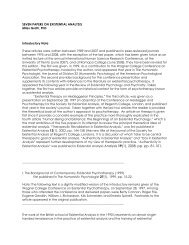The Sonate auf Concertenart: A Postmodern Invention? David ...
The Sonate auf Concertenart: A Postmodern Invention? David ...
The Sonate auf Concertenart: A Postmodern Invention? David ...
You also want an ePaper? Increase the reach of your titles
YUMPU automatically turns print PDFs into web optimized ePapers that Google loves.
<strong>Sonate</strong> <strong>auf</strong> <strong>Concertenart</strong>, p. 39<br />
107<br />
between voices and instruments (ex. 7). In seventeenth-century examples, these familiar devices<br />
are usually not yet coordinated with a large-scale tonal scheme. Telemann may have been one of<br />
the first to incorporate such thinking consistently into the opening passages of movements of<br />
trios, quartets, and other familiar eighteenth-century instrumental genres. J. S. Bach rarely<br />
employs the sort of local contrast at the beginning of a movement that might threaten<br />
108<br />
discontinuity or incoherence. But Telemann's approach evidently found imitators in such<br />
younger contemporaries as C. P. E. Bach (who was Telemann's godson).<br />
Bach's use of alternative schemes<br />
If Bach's contemporaries were busy exploring the possibilities of all sorts of "duologuing" designs<br />
in both instrumental and vocal music at precisely the time when he began composing, shortly after<br />
1700, what we call the Vivaldian concerto was just one manifestation of the process. My second<br />
suggestion, then, is that we seek to understand more clearly how Bach learned the principles<br />
involved and how their application in his music differs from the same in that of his<br />
contemporaries. For instance, a number of early keyboard movements have rondo-like designs<br />
whose modulating scheme is articulated by a returning thematic idea; among these are the<br />
one-movement sonata in A minor BWV 967 and several movements from the manualiter<br />
109<br />
toccatas. Fugal works sometimes take similar forms, notably the Capriccio in E (BWV 993) and<br />
several others in which a lengthy subject alternates with long episodes composed of virtuoso<br />
passagework.<br />
110<br />
It is easy to understand such works by analogy to the solo concerto. But by explaining<br />
107 For another example, see the opening chorus of Der Gottlose ist wie ein Wetter, TWV<br />
1:251 (in Dl Ms. ms. 2392-E-576), whose textual antithesis is reflected in the alternation between<br />
an opening homophonic section (with adagio interpolations) and a fugato on the words aber der<br />
Gottseliger.<br />
108<br />
Exceptions occur in vocal works whose text suggests it, as in the vivid bass solo<br />
movement "Wenn einstens die Posaunen schallen" of Cantata 127 that alternates between arioso<br />
and aria style to depict the Apocalypse.<br />
109<br />
In a lost manuscript copy of the G-major toccata BWV 916, Heinrich Nicolaus Gerber,<br />
a student of Bach, called it Concerto seu Toccata pour le Clavecin. But it is impossible to know<br />
whether the first word of his title referred to the quasi-ritornello design of the first movement, the<br />
three-movement form of the piece as a whole (unique among the manualiter toccatas), or the<br />
general character of the figuration in the first movement, which makes constant use of several<br />
motives reminiscent of the Venetian violin concerto.<br />
110<br />
Rondo form and fugue occur in early concertos, both, for example, occurring in<br />
different movements of the Telemann double concerto copied by J. S. Bach (TWV 52:G2). <strong>The</strong>re<br />
the first quick movement is a fugue in six real parts; fugue comprises the whole of the movement<br />
and not merely the ritornellos (as in the last movement of Bach's A-minor violin concerto, BWV<br />
1041).















